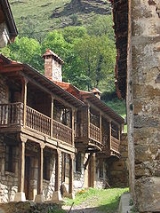
Architecture of Cantabria
Encyclopedia
cantabria.jpg)
Architecture
Architecture is both the process and product of planning, designing and construction. Architectural works, in the material form of buildings, are often perceived as cultural and political symbols and as works of art...
of Cantabria
Cantabria
Cantabria is a Spanish historical region and autonomous community with Santander as its capital city. It is bordered on the east by the Basque Autonomous Community , on the south by Castile and León , on the west by the Principality of Asturias, and on the north by the Cantabrian Sea.Cantabria...
has a long history. In medieval times, artistic individuality was subordinated to ingenuity in civil works. Late Gothic
Gothic architecture
Gothic architecture is a style of architecture that flourished during the high and late medieval period. It evolved from Romanesque architecture and was succeeded by Renaissance architecture....
, Plateresque
Plateresque
Plateresque, meaning "in the manner of a silversmith" , was an artistic movement, especially architectural, traditionally held to be exclusive to Spain and its territories, which appeared between the late Gothic and early Renaissance in the late 15th century, and spread over the next two centuries...
, and renaissance architecture
Renaissance architecture
Renaissance architecture is the architecture of the period between the early 15th and early 17th centuries in different regions of Europe, demonstrating a conscious revival and development of certain elements of ancient Greek and Roman thought and material culture. Stylistically, Renaissance...
later played a role in Cantabrian architecture, as did the province's mountain quarries. The contemporary era is dominated by a regional architectural tradition that incorporates diverse influences from around the world.
The traditional mountain architecture of Cantabria, even with its differing local varieties, is a cultural heritage that has been preserved over time. These forms are based on a way of understanding architecture and applied materials, harmony with the Cantabrian environment and climate, and the continuation of ancestral customs. Within this vernacular architecture, the Cantabrian house stands out as the most traditional and typical. Cantabrian houses range from humble shepherd huts to the palaces and mountain mansions of the rich, from traditional mountain homes to the modest huts of the Pas valley
Pas and Miera valleys
The Valleys of the Pas and Miera Rivers comprise an administrative comarca in Cantabria, Spain. It is formed by the valleys of said rivers, each one being a natural comarca of its own.-Pas valley:...
.

